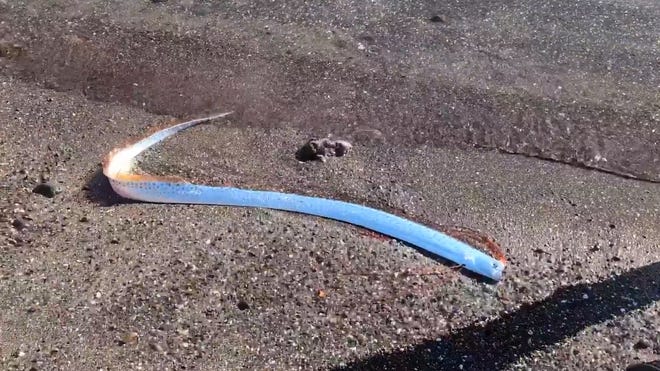Mexico beachgoers were treated to a rare sighting earlier this month of a shimmering oarfish , native to the deep sea and seen in Japanese folklore as a signal of impending doom.
The “doomsday” fish was spotted alive at the nation’s Baja California Sur beach Feb. 9, according to AccuWeather and FOX affiliate KMSP-TV .
Video shows the marine serpent swimming by the shore in the clear shallow waters while stubbed beachgoers surround it. When the fish stops moving someone proceeds to gently grabbed and moved toward the water.
“What are you doing?” one witness asks the fish in the video.
“That’s an oarfish. They’re almost never seen live,” another says.
In 2024, there were at least three separate oarfish sightings in Southern California , including one in San Diego last August that marked the region’s first spotting in nearly 125 years . However, all three fish were found dead.
Where were oarfish spotted in California last year?
In August, a 12-foot-long dead oarfish was recovered by a group of “sciencey” kayakers and snorkelers swimming at La Jolla Cove in San Diego.
In September, a second oarfish was found dead in Orange County’s Huntington Beach in September according to Ben Frable, an in-house fish expert for the Scripps Institution of Oceanography.
On Nov. 6, a roughly 10-foot oarfish was found dead at a beach in Encinitas, around 25 miles north of San Diego, Frable confirmed.
How are oarfish an omen of impending disaster?
The sight of a “doomsday fish” in shallow waters serves as an omen of an impending earthquake dating back to 17th century Japan, according to travel outlet Atlas Obscura .
Japanese folklore indicates the fish belonged to servants of the sea god Ryūjin. Hence the fish are also known as “ryugu no tsukai,” which translates to “messenger from the sea god’s palace.” It’s believed the oarfish were sent from the palace toward the surface to warn people of earthquakes.
What do scientists say dead oarfish sightings mean?
Scientists are unable to theorize the reason why three oarfish have washed ashore last year, saying that each specimen collected provides a unique opportunity to learn more about the species.
Especially since there is more than one variable at play in the so-called “strandings” of the oarfish, including shifts in the climate patterns of El Niño and La Niña, Frable said in November.
This article was originally published by a www.usatoday.com . Read the Original article here. .

